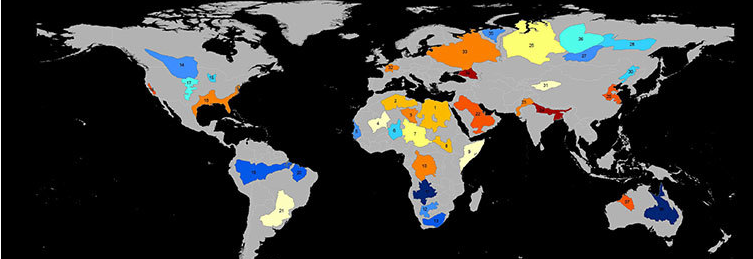Study: A third of big groundwater basins in distress
By Alan Buis, NASA’s Jet Propulsion Laboratory,
and Janet Wilson, University of California, Irvine

Groundwater storage trends for Earth’s 37 largest aquifers from UCI-led study using NASA GRACE data (2003 - 2013). Of these, 21 have exceeded sustainability tipping points and are being depleted, with 13 considered significantly distressed, threatening regional water security and resilience. Credit: UC Irvine/NASA/JPL-Caltech. View larger image.
Groundwater storage trends for Earth’s 37 largest aquifers from UCI-led study using NASA GRACE data (2003 - 2013). Of these, 21 have exceeded sustainability tipping points and are being depleted, with 13 considered significantly distressed, threatening regional water security and resilience. Credit: UC Irvine/NASA/JPL-Caltech. View larger image.
About one third of Earth’s largest groundwater basins are being rapidly depleted by human consumption, despite having little accurate data about how much water remains in them, according to two new studies led by the University of California, Irvine (UCI), using data from NASA’s Gravity Recovery and Climate Experiment (GRACE) satellites.
This means that significant segments of Earth’s population are consuming groundwater quickly without knowing when it might run out, the researchers conclude. The findings are published today in Water Resources Research.
“Available physical and chemical measurements are simply insufficient,” said UCI professor and principal investigator Jay Famiglietti, who is also the senior water scientist at NASA’s Jet Propulsion Laboratory in Pasadena, California. “Given how quickly we are consuming the world’s groundwater reserves, we need a coordinated global effort to determine how much is left.”
The studies are the first to comprehensively characterize global groundwater losses with data from space, using readings generated by NASA’s twin GRACE satellites. GRACE measures dips and bumps in Earth’s gravity, which are affected by the mass of water. In the first paper, researchers found that 13 of the planet’s 37 largest aquifers studied between 2003 and 2013 were being depleted while receiving little to no recharge.
The most overburdened aquifers are in the world’s driest areas, where populations draw heavily on underground water. Climate change and population growth are expected to intensify the problem.
Eight were classified as “overstressed,” with nearly no natural replenishment to offset usage. Another five were found to be “extremely” or “highly” stressed, depending upon the level of replenishment in each. Those aquifers were still being depleted but had some water flowing back into them.
The most overburdened aquifers are in the world’s driest areas, where populations draw heavily on underground water. Climate change and population growth are expected to intensify the problem.
“What happens when a highly stressed aquifer is located in a region with socioeconomic or political tensions that can’t supplement declining water supplies fast enough?” asked Alexandra Richey, the lead author on both studies, who conducted the research as a UCI doctoral student. “We’re trying to raise red flags now to pinpoint where active management today could protect future lives and livelihoods.”
The research team—which included co-authors from NASA, the National Center for Atmospheric Research, National Taiwan University and UC Santa Barbara—found that the Arabian Aquifer System, an important water source for more than 60 million people, is the most overstressed in the world.
The Indus Basin aquifer of northwestern India and Pakistan is the second-most overstressed, and the Murzuk-Djado Basin in northern Africa is third. California’s Central Valley, used heavily for agriculture and suffering rapid depletion, was slightly better off, but was still labeled highly stressed in the first study.
“As we’re seeing in California right now, we rely much more heavily on groundwater during drought,” said Famiglietti. “When examining the sustainability of a region’s water resources, we absolutely must account for that dependence.”
In a companion paper published today in the same journal, the scientists conclude that the total remaining volume of the world’s usable groundwater is poorly known, with estimates that often vary widely. The total groundwater volume is likely far less than rudimentary estimates made decades ago. By comparing their satellite-derived groundwater loss rates to what little data exist on groundwater availability, the researchers found major discrepancies in projected “time to depletion.” In the overstressed Northwest Sahara Aquifer System, for example, time to depletion estimates varied between 10 years and 21,000 years.
“We don’t actually know how much is stored in each of these aquifers. Estimates of remaining storage might vary from decades to millennia,” said Richey. “In a water-scarce society, we can no longer tolerate this level of uncertainty, especially since groundwater is disappearing so rapidly.”
The study notes that the dearth of groundwater is already leading to significant ecological damage, including depleted rivers, declining water quality and subsiding land.
Groundwater aquifers are typically located in soils or deeper rock layers beneath Earth’s surface. The depth and thickness of many large aquifers make it tough and costly to drill or otherwise reach bedrock and understand where the moisture bottoms out. But it has to be done, the authors say.
To read the technical papers, visit here and here.
GRACE is a joint mission with the German Aerospace Center and the German Research Center for Geosciences, in partnership with the University of Texas at Austin. JPL developed the GRACE spacecraft and manages the mission for NASA’s Science Mission Directorate, Washington.
Learn more about GRACE here and here.
via Climate Change: Vital Signs of the Planet: Study: A third of big groundwater basins in distress.
Like this:
Like Loading...



















